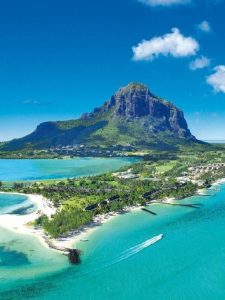Beyond description, Mauritius is breathtaking, rich in stunning white sand beaches, magnificent crystal clear turquoise lagoons, natural waterfalls, unusual animals, rugged mountains, and other tourist attractions. Both natural and artificial sights of every kind can be found on the Island.
In addition, it features a subtropical temperature, picture-perfect beaches, tranquil seas, tropical flora, and animals, as well as diverse people that are hospitable and accepting.
These tourism-related resources are Mauritius’ most significant asset, especially since world-class beach resorts, hotels, operational services, and architecture support them.
And for this reason, behind the industrial industry and agriculture, tourism is Mauritius’ third most important economic sector.
The Island’s economy has grown dramatically due to the tourist industry, which has also played a crucial role in Mauritius’ overall development.
In reality, visitor arrivals during the last two decades have climbed at an average annual rate of 9%, while tourism-related revenue has increased by roughly 21%. As a result, a little over 14% of Mauritius’ GDP came from tourism.
The “opening of the skies” action plan is a new approach that its government has embraced to grow the local tourism sector.
The fundamental goal here is to create new markets, which includes expanding into new nations and attracting new types of customers.
Additionally, to increase the number of rooms available on the Island, the Mauritius government promotes the construction of new hotels.
And as a result, tourism has emerged as one of the most significant and rapidly growing sectors of the global economy.
The economy of a nation benefits significantly from just this one industry.
A boost in tourism can help the nations’ economies, especially in terms of GDP and employment opportunities. However, the objective of this effort is to travel to the locations without putting the locals or the environment at risk while positively impacting society, the ecology, and the country’s economy.
Tourism may include the following elements: travel to the location, local transit, hotel, leisure, entertainment, shopping, and dining.
Travel for work, leisure, family, or friends may be included.
Although there is disagreement about how to accomplish this, there is a consensus that tourism expansion should be sustainable.
Consequently, the travel and tourism industries play a significant role in the global economy.
And for this reason, the tourist sector continues to play a significant role in creating jobs and money in many nations’ formal and unofficial sectors.
For instance, the Mauritian tourist industry, positioned at the top of the global market, contributes significantly to the Island’s gross domestic product (GDP).
Additionally, FDI has dramatically benefitted the diversification of the Mauritian economy and the Island’s economic expansion.
The economy has also benefited from FDI in several ways, including increased productivity, technological advancements, adopting new practices, managerial abilities, and market expertise.
With its GDP per capita rising from US$260 in 1968, the year of independence, to more than US$7000 in 2013, Mauritius is most of the time known to be one of the wealthiest and most successful African economies. For the past 25 years, the country’s economy has grown almost continuously at about 5% annually.
Given its limited domestic market, the Mauritian economy’s performance can be mainly attributable to its trade openness policy.
On the other hand, sugar, textiles, and tourism have historically been vital components of growth.
In addition, the economy has expanded into financial services, information technology, and computer science while maintaining its historic industry basis.
Bold reforms were implemented in 2005 by the nation that altered the environment for commercial activity in Mauritius. These included labour reforms, revisions to legislation relating to the ease of doing business, and the liberalization of tariffs (the idea of a duty-free island).
The significant infrastructural investment was also made in the economy, and there was broad agreement about switching to more significant value-added industries.
Therefore, these reforms have helped to strengthen and increase the economy’s competitiveness.
The Mauritian story, however, is built on five pillars: political leadership, robust institutions, ethnic diversity, a class of local entrepreneurs, and a well-organized private sector that regularly engages the government in policy discussions.
Along with this, the revolution has always ensured a balance between social and economic goals, emphasizing human capital through free healthcare and education and a minimally adequate social safety net for the most vulnerable.
After the previous year has closed, Trading Economics global macro models and experts anticipate that foreign direct investment in Mauritius will reach 19000.00 MUR Million.
The econometric models predict that over the long term, foreign direct investment in Mauritius will trend around 19000.00 MUR Million in 2023.



